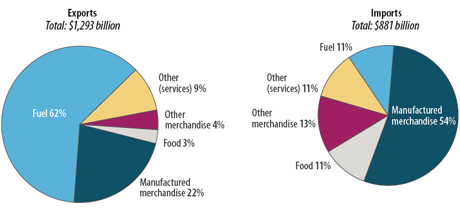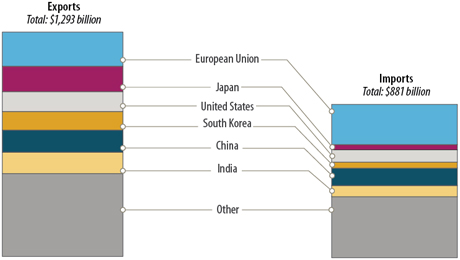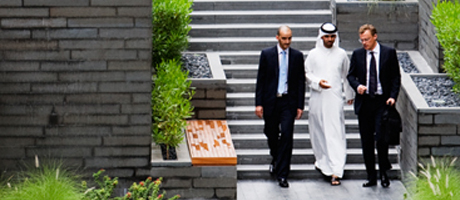The Middle East economic future looks bright both in the short term and longer term
The Middle East comprises a diverse set of countries with very different characteristics. It is a region that carries many stereotypes and myths. With a combined population of about 320 million, the region forms an area of tremendous strategic and economic importance to the United States.
Key market opportunities for U.S. firms will continue to be present in aerospace & defense, architectural, engineering and design, project management, security, urban transport, rail, oil & gas and power generation -including alternative & renewable energy. The King Abdullah City for Atomic and Renewable Energy has a stated goal to spend more than $150 billion to develop renewable energy capabilities, specifically solar, to reduce the country’s reliance on burning oil for domestic power generation.
80% of businesses in the Middle East are family owned or controlled. These businesses play a crucial role in sustaining growth, improving society, and contributing to substantial economic development.
Growth and Resilience
Over the last decade, the Middle East region, and in particular the GCC countries, has established itself as a key driver of growth in several sectors. Market indicators and specific mega projects include:
- Saudi Arabia is the 9th largest trading partner of the United States with a bilateral trade of almost $80 billion in 2013 and is also the 20th largest destination for U.S. exports.
- The Saudi private sector has been the key driver behind the stronger non-oil sector growth, with an annual growth rate close to 7 percent since 2000. The country has benefited enormously from oil and gas reserves that have generated vast financial liquidity. As a result, there are currently about $960 billion worth of projects planned or under way in Saudi Arabia.
- The Emirate of Abu Dhabi is developing a $10 billion urban transit system -light rail and below ground subway, a national railroad network and a nuclear energy industry.
- Over $40 billion of developments of Dubai’s new Al Maktoum airport and adjacent logistics, commercial, residential and recreational sites, and over 100 new hotels and multiple venues for the 2020 World Expo.
- $22.5 billion Riyadh Metro, along with rail schemes in Mecca, Jeddah, Medina and Dammam, promises to transform transport infrastructure.
- Demand for power generation throughout the region will continue to climb over the next five to ten years on the back of a rapidly growing population, and resulting high investments in social and physical infrastructure.
- Over the past 10 years U.S. exports to Qatar have grown by over 700%.
- Qatar plans to spend over $250 billion on physical infrastructure over the next five years.
- Projects worth US$2 billion, including the expansion of Baku’s metro system and the Gazakh Cement Plant, which has a production capacity of 3 million tonnes per year
- Istanbul's undersea rail tunnel linking Asia with Europe -the world's deepest undersea tunnel at 185 feet- shuttles 1.5 million people a day.
The Region's Exports and Imports of Goods and Services with the World, by Commodity or Type of Service, 2011

Source: World Bank, World Development Indicators
Mapping Future Prospects
Trade and investment between the Middle East-Eurasia region and the United States is relatively limited, suggesting scope for deeper economic ties. U.S. trade with the region's countries accounts for a small share of total U.S. trade: $193 billion, about 5% of the U.S. total, in 2011. U.S.-ME trade primarily consists of exchanging a wide variety of U.S. goods for crude oil, which is then processed and refined into such petroleum end-products as gasoline, diesel fuel, heating oil, kerosene, and liquefied petroleum gas.
Closely linked to trade is Foreign Direct Investment (FDI). The Middle East-Eurasia region accounts for a small share of global FDI by U.S. firms (“outward” FDI). In 2011, the total stock of U.S. outward FDI was $4.2 trillion. Of this, about only $56 billion, or 1%, was invested in the Middle East-Eurasia region.
The Region's Major Trading Partners, 2011

Source: International Monetary Fund (IMF), Direction of Trade Statistics
Notes: Merchandise data only; services data not available
Long-term Benefits Combined with Real Growth
JS&A helps clients achieve global competitive advantage. We have deep experience helping clients achieve and accelerate growth in their core business and beyond in markets around the world. We combine in-depth customer insights with market expertise to help our clients create sustainable and organic growth.

